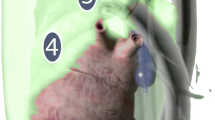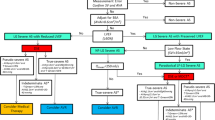Summary
The aim of this serial 3 year follow-up study in 42 clinically stable patients with chronic aortic dissection was to assess quantitatively morphologic changes of the descending thoracic aorta (AD) using transesophageal echocardiography (TEE). Communicating dissections (ca) were present in 16/19 patients with operated type I and in 11/23 patients with type III AD wherase 12/23 type III AD according to De Bakey were non-communicating (nc). Diametral enlargement of the desc. thoracic aorta was 4 mm (mean value) at 1 year in all patients, 5.9 mm in type I ca, 7.2 mm in type III ca but only 3.1 mm in type III nc at 3 years. The ration between true lumen and false lumen (FL) changed in ca AD from 1:2 to 1:3 over the period of 3 years but remained constant at 1:1 in ncAD. Progressive thrombosis of the false lumen (FL) occurred in 76 % of patients but complete thrombosis of the FL occurred in only 6 % of type I ca, 18 % type III ca but in 84 % of type III nc patients.
Our results confirm observations that non-communicating dissections seem to have a more favorable outcome and less aneurysmal dilatation compared to ca dissection.
Zusammenfassung
Das Ziel dieser Verlaufsuntersuchung von 42 klinisch stabilen Patienten mit chronischen Aortendissektionen (19 Typ-I-; 23 Typ-III-Dissektionen nach De Bakey) war es, quantitativ die morphologischen Veränderungen an der Aorta descendens im Verlauf von 3 Jahren mittels serieller transösophagealer echokardiographischer Untersuchungen zu beurteilen.
Kommunizierende Dissektionen (ca) waren bei 16 von 19 Patienten mit Typ-I- und 11 von 23 Patienten mit Typ-III-Dissektionen nachweisbar. Hingegen war bei 12 von 23 Patienten mit Typ-III-Dissektionen keine Kommunikation nachweisbar (nc). Die Erweiterung der deszendierenden Aorta lag nach 1 Jahr im Mittel bei 4 mm und betrug nach 3 Jahren bei Patienten mit Typ-I(ca)- 5,9 mm, bei Typ-III(ca)- 7,2 mm und bei Typ-III-(nc)-Dissektionen nur 3,1 mm. Das Verhätnis wahres zu falschem Lumen (FI) nahm von 1:2 auf 1:3 bei Typ-I- und -III(ca)-Dissektionen zu, blieb jedoch konstant bei 1:1 bei Typ-III(nc)-Dissektionen.
Das Ausmaß der Thrombosierung war über 3 Jahre progredient in 76 % der Patienten. Komplette Thrombosierungen waren nur bei 6 % mit Typ-I(ca)-, 18 % mit Typ-III(ca)-, jedoch bei 85 % der Patienten mit Typ-III(nc)-Dissektionen nachweisbar. Diese Untersuchung bestätigt die Beobachtungen, daß nicht-kommunizierende Dissektionen im Hinblick auf eine aneurysmatische Erweiterung der Aorta prognostisch günstiger sind. Die quantitativen Werte können als Referenz für die Verlaufsbeurteilung von Patienten mit chronischen Aortendissektionen genutzt werden.
Similar content being viewed by others
Author information
Authors and Affiliations
Additional information
Eingegangen: 25. Mai 1998, Akzeptiert: 9. Februar 1999
Rights and permissions
About this article
Cite this article
Mohr-Kahaly, S., Erbel, R., Stühn, A. et al. Quantitative Erfassung von Veränderungen der thorakalen Aorta bei Patienten mit chronischer Aortendissektion mittels transösophagealer Echokardiographie. Z Kardiol 88, 507–513 (1999). https://doi.org/10.1007/s003920050315
Issue Date:
DOI: https://doi.org/10.1007/s003920050315




